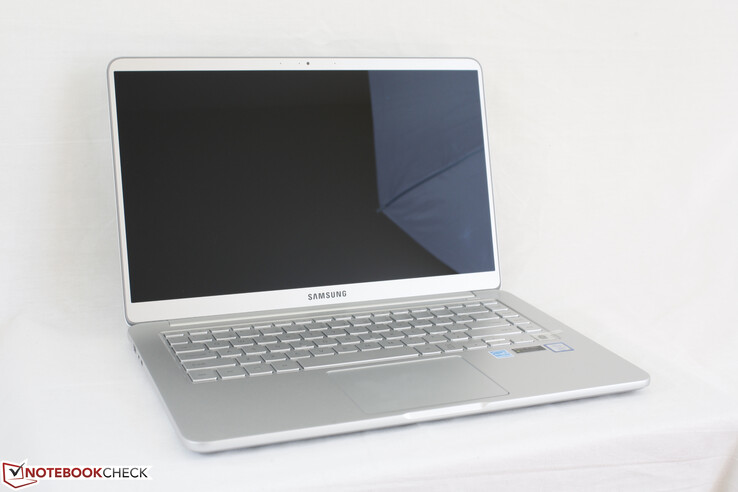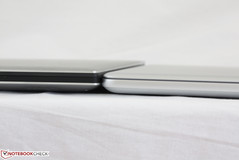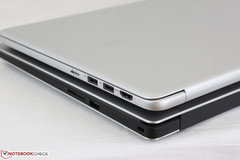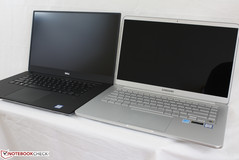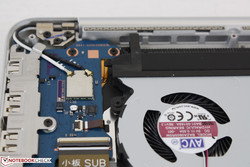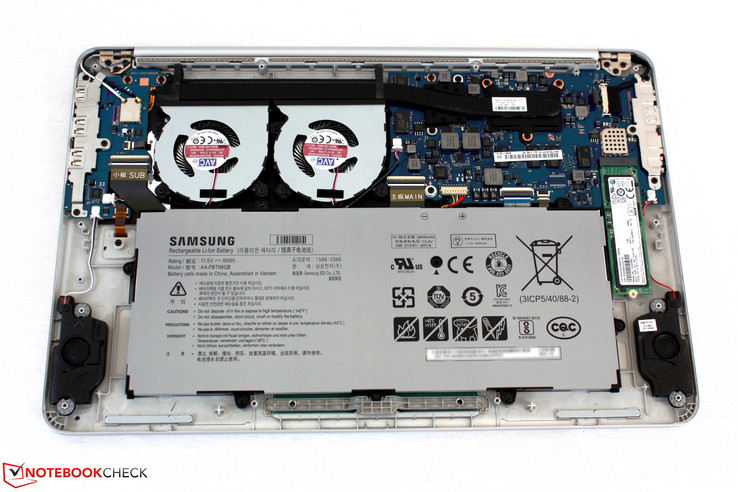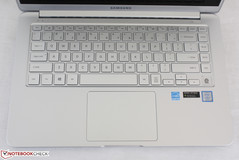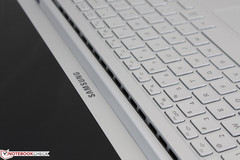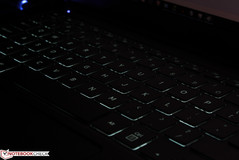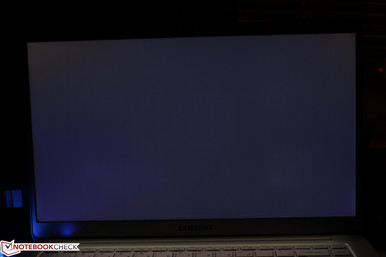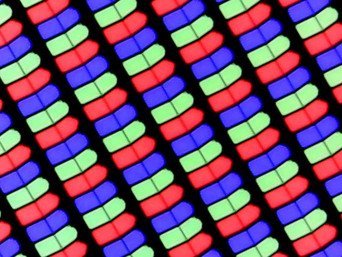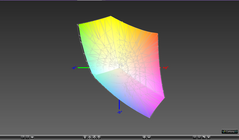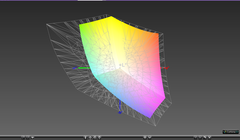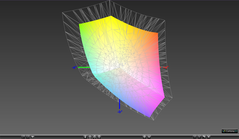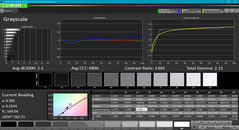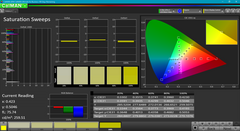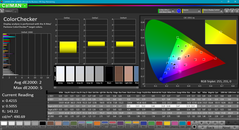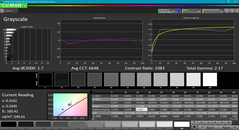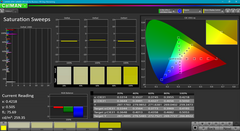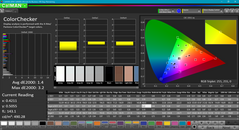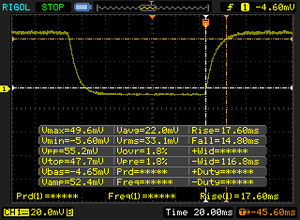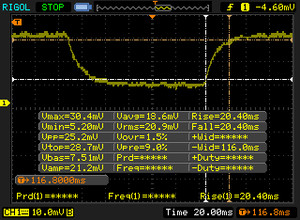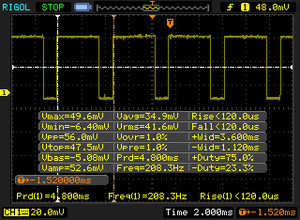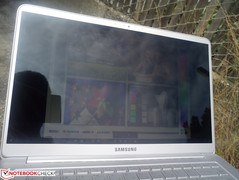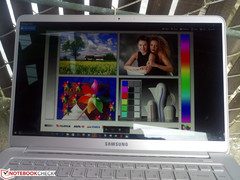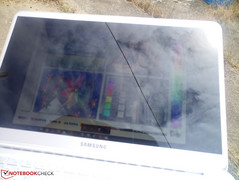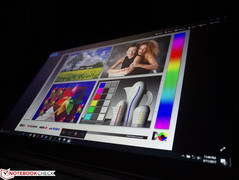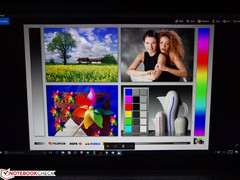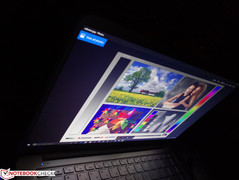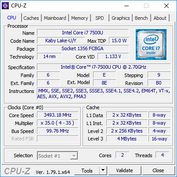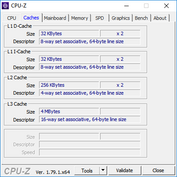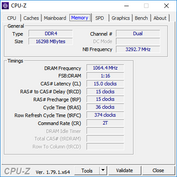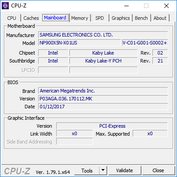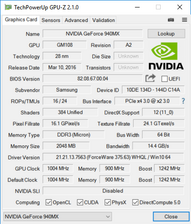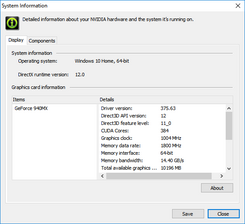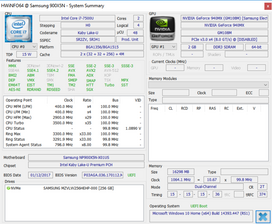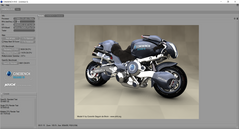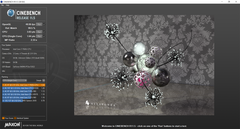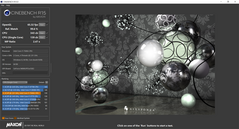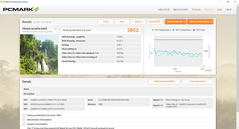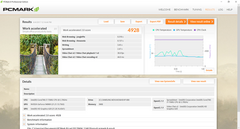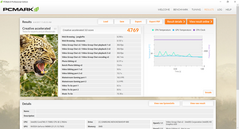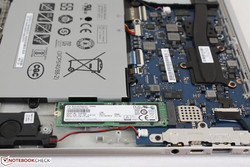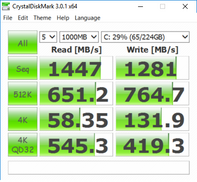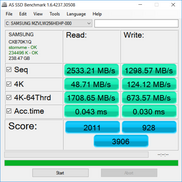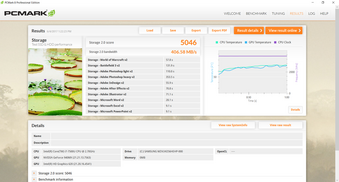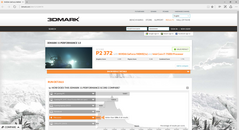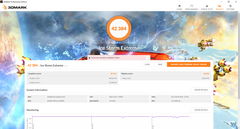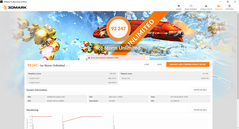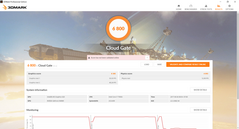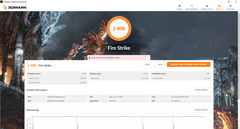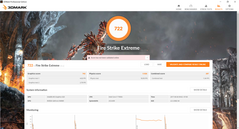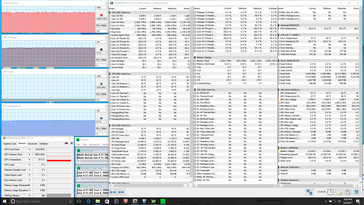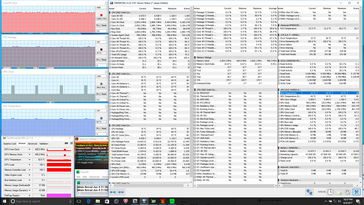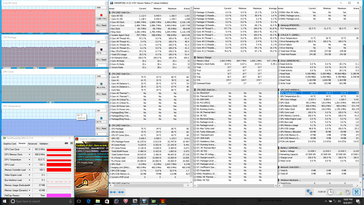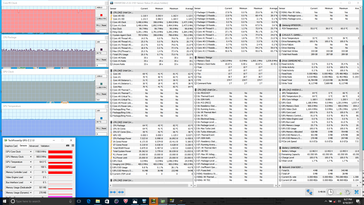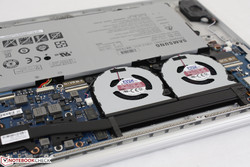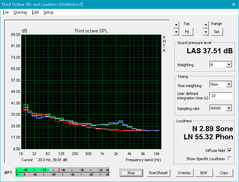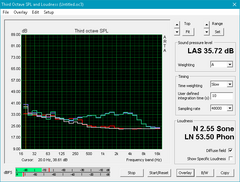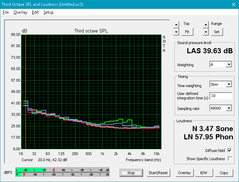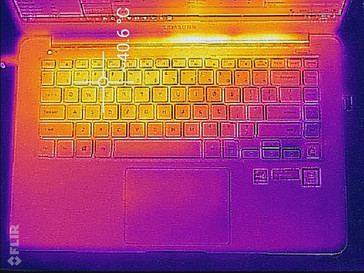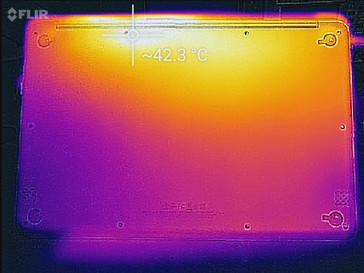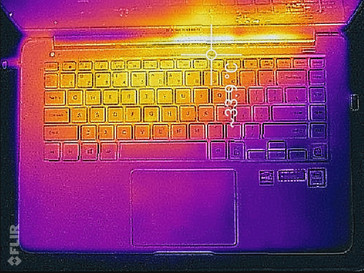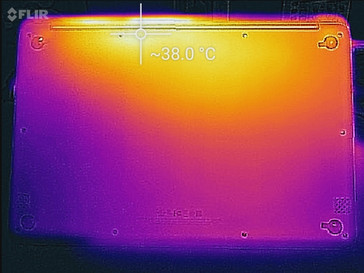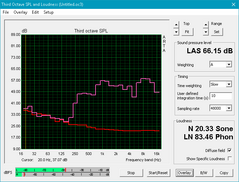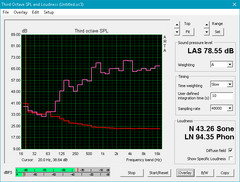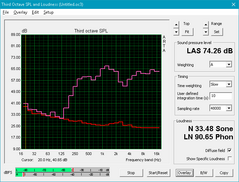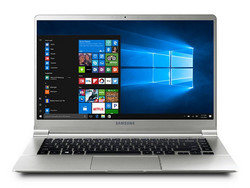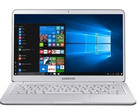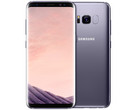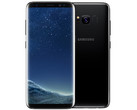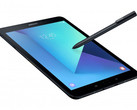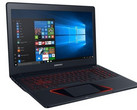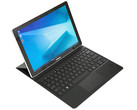Samsung Notebook 9 NP900X5N (7500U, FHD, GeForce 940MX) Laptop Review
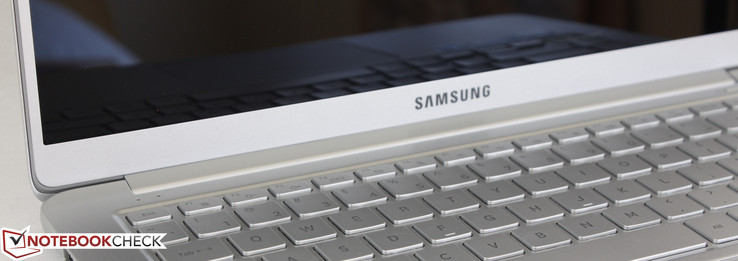
Samsung laptops don't receive nearly the same marketing push or recognition as the almighty Galaxy S series of smartphones and it's a bit of a shame as the ATIV Book/Notebook 9 flagship series has always scored quite well in our tests. At CES 2016, for example, the Notebook 9 refresh was but a small desk with only a handful of demos in the sea of Galaxy Tabs and other Samsung products. The even lesser-known ATIV Book 5, Book 6, and Book 8 models all exhibit great displays and runtimes in very lightweight designs that mimic the MacBook Air series.
The latest model in the underrated series is the 15.0-inch Notebook 9 Always (NP900X5N) with a Core i7-7500U CPU, FHD glossy display, GeForce 940MX GPU, 16 GB of RAM, 66 Wh battery, and 256 GB NVMe SSD as reviewed here for approximately $1400 USD. A second lower-end SKU (NP900X5MI) with the i5-7200U CPU, 8 GB of RAM, 30 Wh battery, and no dedicated GPU is also available, but we could find no such configuration in stock at least in North America. A smaller 13.3-inch version of the Notebook 9 (NP900X3N) exists as well with similar features as the NP900X5MI that we'll likely check out in the near future.
The NP900X5N with Kaby Lake is the first Notebook 9 model to stop by our labs in over three years. A lot has changed since then with the 15.0-inch Samsung sandwiched between new competitors in both the 14-inch space (ZenBook UX3410, ThinkPad X1 Carbon) and the more common 15.6-inch space (VivoBook S510, XPS 15). For this review, we'll see how the Samsung stacks up against these more popular Ultrabooks in the market.
Case
Our first impression of the new Notebook 9 is how incredibly lightweight it is without resorting to cheap plastic materials. The notebook utilizes thin metal treated with "Micro Arc Oxidation Technology" and the result is a slightly roughened and textured matte surface from top to bottom. The lack of any glossy finishing or brushed surfaces make the system appear plastic with a similar gray color tone to the MacBook Pro. It's definitely understated in design compared to the lengths competitors go to create more unique looks such as the piston hinges of the Spectre 13, brushed concentric surfaces of the Zenbook 3, or distinctive wristband hinge of the Yoga 900 series.
Rigidity is perhaps the weakest aspect of the design. We're always wary of thin displays and narrow bezels simply because there is a higher chance of a more flexible lid. Dell has proven that this doesn't necessarily have to be the case with the excellent InfinityEdge XPS 13 and XPS 15 designs, but we can't say the same for Samsung. The lid here is far more susceptible to twisting and bending than both the XPS 15 and Spectre 13 and feels extremely fragile despite the clean minimalist look. The base is fortunately more rigid compared to something like the Yoga 910, though it doesn't come close to the MacBook Pro 15 or XPS 15. Its palm rests and keyboard surface, for example, show moderate warping when applying pressure with a finger. On the other hand, the wide bar hinge is sufficiently taut to prevent teetering when typing on a flat desk and can be opened up to 180 degrees. If at angles greater than about 140 degrees, however, the hinge becomes looser and will have trouble maintaining a fixed angle. While the chassis is not poor by any means, it's certainly not as firm or inelastic as competing ultra-thin flagships.
Build quality is otherwise excellent with no unintended gaps or defects on our particular test unit including the inner bezels of the screen. It can be somewhat difficult to lift open the display when it is in a closed position as the front notch is small and hard to grip. Creaking is fortunately nonexistent unless if attempting to twist the base with an improper amount of force.
The 15.0-inch screen size automatically gives Samsung the weight and size advantage over 15.6-inch competitors with the even lighter LG Gram 15 being a notable exception. With this in mind, the Notebook 9 still manages to be lighter and thinner than some 14-inch notebooks including the Asus UX3410UQ. Both the MacBook Pro 15 and XPS 15 may offer slightly larger display sizes with very similar dimensions to our Samsung, but both are significantly heavier and denser by several hundred grams. Users will be hard pressed to find a 15-inch notebook as light as our Notebook 9 as even the Surface Pro 4 with its keyboard attachment is only about 150 g lighter.
Connectivity
Ports are limited to HDMI, 3x USB, and Thunderbolt 3. Fortunately, the Thunderbolt port should provide a wide range of docking and external display options if needed. Charging cannot be done through USB Type-C or the adjacent proprietary connector. It would have been more convenient to see Samsung drop the AC adapter port and include two USB Type-C ports similar to the Spectre 13 or EliteBook x360 series, but having multiple Thunderbolt 3 ports would have likely been costlier. Nonetheless, we're satisfied with what is available as the competing Zenbook 3 and MacBook Pro 15 systems integrate no USB Type-A or HDMI ports at all.
It's worth noting that Samsung explicitly advertises the full 40 Gbps bandwidth for its Thunderbolt 3 port whereas this same port on the Dell XPS 15 utilizes only half the bandwidth.
SD Card Reader
The integrated spring-loaded MicroSD reader performs similarly to the MicroSD reader found on the Latitude 12 5285 with an average transfer rate in the mid 80 MB/s range. Transferring 1 GB worth of photos from our Toshiba Exceria Pro M401 test card to desktop will take about 15 seconds. While a MicroSD reader is appreciated, it's a bit disappointing that the system omits a full-size SD reader especially when the older and thinner 13-inch Notebook 9 NP900X3C managed to fit one in back in 2012.
| SD Card Reader | |
| average JPG Copy Test (av. of 3 runs) | |
| Dell XPS 15 9560 (i7-7700HQ, UHD) | |
| Samsung Notebook 9 NP900X5N-X01US | |
| Dell Latitude 12 5285 2-in-1 | |
| maximum AS SSD Seq Read Test (1GB) | |
| Dell XPS 15 9560 (i7-7700HQ, UHD) | |
| Dell Latitude 12 5285 2-in-1 | |
| Samsung Notebook 9 NP900X5N-X01US | |
Communication
The 2x2 Intel 8265 WLAN module comes standard and, unlike on most notebooks, is of the M.2 1216 variety instead of M.2 2230 or 2242. This appears to have no performance or connectivity consequences as we are able to record a real-world transfer rate of 668 Mbps when paired with our Linksys EA8500 test router. WWAN options would have been a great addition to further accentuate the portability of the notebook.
| Networking | |
| iperf3 transmit AX12 | |
| Dell XPS 15 9560 (i7-7700HQ, UHD) | |
| Samsung Notebook 9 NP900X5N-X01US | |
| Dell XPS 13 9365-4537 2-in-1 | |
| iperf3 receive AX12 | |
| Samsung Notebook 9 NP900X5N-X01US | |
| Dell XPS 15 9560 (i7-7700HQ, UHD) | |
| Dell XPS 13 9365-4537 2-in-1 | |
Accessories
There are no included extras in the box beyond the AC adapter and Quick Start guide. A carrying sleeve or velvet cloth would have been neat additions especially at this price range. Fortunately, the presence of Thunderbolt 3 gives the notebook plenty of expandability options down the road.
Maintenance
Serviceability requires only a Philips screwdriver and sharp edge. Unlike on some recent Asus notebooks, there are thankfully no screws hidden underneath the rubber footing and the panel will pop off quite easily. Users will have direct access to the M.2 SSD, internal battery, and system fans. RAM is soldered and so we suggest choosing carefully between the 8 GB and 16 GB SKU.
Warranty
The standard one-year limited manufacturer warranty applies while the battery is covered for only the first six months. There is no "zero dead pixel policy" as Samsung will only replace units with more than five dead pixels.
Input Devices
Keyboard
The Chiclet keyboard offers a surprisingly firm keystroke with a travel of 1.5 mm compared to 1.3 mm on the Spectre 13 or 1.6 mm on the ZenBook Pro UX501. We were expecting feedback to be softer because the center of the keyboard base warps a bit too easily for our liking, but this does not appear to be the case with the exception of the half-sized Arrow keys as they feel spongier than the rest of the keys. The new Notebook 9 is one of the more comfortable laptops to type on for its size class with the main drawback being its loud clatter. The ThinkPad AccuType or XPS 15 keyboard are comparatively quieter if noise is an issue.
The three-level backlight continues to be teal-green in color instead of the usual white on most notebooks. This color difference has the benefit of being easier on the eyes if typing in a very dark room, but it is slightly dimmer than a white backlight. Note that the keyboard backlight is tied to the ambient light sensor and will only trigger once the surrounding environment is considered too dim.
Touchpad
The large trackpad (11.0 x 8.0 cm) is completely smooth for better gliding properties than the roughened surrounding palm rests. Both cursor control and multi-touch gestures of up to four fingers respond swiftly as one would expect with no jitters or random jumps. Meanwhile, the integrated mouse keys are very shallow in travel with just average feedback and a slightly muffled auditory click. It's not terrible, but it takes quite a bit of force to push down on the trackpad surface unless if your finger is directly on the bottom left or right corner.
Display
The 1080p display is definitely the highlight of the notebook. Texts and images are very crisp with no hints of graininess due to the overlying glossy panel. Colors are vibrant and appear to pop since there is no thick layer of glass between the panel and the outer surface of the screen. Contrast is excellent and on par with competing Ultrabooks with faster display response times than both the MacBook Pro 15 and the Sharp IGZO panel on the XPS 15 9560. The BOE HF NV150FHB-N31 IPS panel on our Samsung can be found on no other notebook in our database at this time likely because the 15.0-inch size category is so uncommon. Unfortunately, no higher resolutions or touchscreen features are available.
A unique feature of the NP900X5N is the Outdoor Mode option that will automatically increase the maximum backlight to an advertised 500 nits. The concept is not unlike on the Galaxy S7/S8 or Galaxy Note series of smartphones where maximum brightness can be toggled even higher than usual for easier outdoor visibility. This is significantly brighter than most Ultrabooks where 300 to 350 nits is the norm and the difference is substantial. In fact, our own independent measurements show Outdoor Mode to be slightly brighter than 500 nits at the very center of the screen. All of our display measurements were performed with Outdoor Mode enabled as we wanted to see the notebook at its very best. Maximum brightness will be limited to 350 nits if Outdoor Mode is toggled off, which is still more than sufficient for indoor use.
Uneven backlight bleeding is minimal around the top left corner and hardly noticeably during day-to-day use. The most unfortunate aspect of the display is the presence of detectable PWM on all brightness levels up to 99 percent regardless of the Outdoor Mode setting. Thus, unless if the brightness setting is always at maximum, users who are sensitive to screen flickering will want to avoid this notebook altogether. The occurrence of PWM here is strange because very few notebooks exhibit this behavior on nearly every brightness setting available.
| |||||||||||||||||||||||||
Brightness Distribution: 88 %
Center on Battery: 565.6 cd/m²
Contrast: 1154:1 (Black: 0.49 cd/m²)
ΔE ColorChecker Calman: 2 | ∀{0.5-29.43 Ø4.77}
ΔE Greyscale Calman: 2.5 | ∀{0.09-98 Ø5}
97.5% sRGB (Argyll 1.6.3 3D)
61.2% AdobeRGB 1998 (Argyll 1.6.3 3D)
67.2% AdobeRGB 1998 (Argyll 3D)
97.7% sRGB (Argyll 3D)
65.2% Display P3 (Argyll 3D)
Gamma: 2.21
CCT: 6896 K
| Samsung Notebook 9 NP900X5N-X01US ID: BOE06E8, Name: BOE HF NV150FHB-N31, IPS, 15", 1920x1080 | Dell XPS 15 2017 9560 (7300HQ, Full-HD) Sharp SHP1453 LQ156M1, LED IGZO IPS InfinityEdge, 15.6", 1920x1080 | Apple MacBook Pro 15 2016 (2.9 GHz, 460) Apple APPA030, IPS, 15.4", 2880x1800 | HP Spectre x360 15-bl002xx UHD UWVA eDP BrightView WLED-backlit , IPS, 15.6", 3840x2160 | Lenovo ThinkPad T570-20HAS01E00 BOE NV156QUM-N44, IPS, 15.6", 3840x2160 | |
|---|---|---|---|---|---|
| Display | 4% | 28% | -3% | -0% | |
| Display P3 Coverage (%) | 65.2 | 68.9 6% | 99 52% | 67.9 4% | 70 7% |
| sRGB Coverage (%) | 97.7 | 98.9 1% | 100 2% | 88.2 -10% | 91.1 -7% |
| AdobeRGB 1998 Coverage (%) | 67.2 | 70.9 6% | 87.3 30% | 64.4 -4% | 66.7 -1% |
| Response Times | -47% | -43% | -14% | 26% | |
| Response Time Grey 50% / Grey 80% * (ms) | 40.8 ? | 54 ? -32% | 46 ? -13% | 44 ? -8% | 41.6 ? -2% |
| Response Time Black / White * (ms) | 32.4 ? | 52.4 ? -62% | 56 ? -73% | 38.8 ? -20% | 15.2 ? 53% |
| PWM Frequency (Hz) | 208.3 ? | 119000 ? | 1000 ? | 926 ? | |
| Screen | -42% | -3% | -9% | -35% | |
| Brightness middle (cd/m²) | 565.6 | 400 -29% | 420 -26% | 351.5 -38% | 339 -40% |
| Brightness (cd/m²) | 524 | 392 -25% | 401 -23% | 336 -36% | 314 -40% |
| Brightness Distribution (%) | 88 | 89 1% | 90 2% | 83 -6% | 89 1% |
| Black Level * (cd/m²) | 0.49 | 0.26 47% | 0.3 39% | 0.24 51% | 0.36 27% |
| Contrast (:1) | 1154 | 1538 33% | 1400 21% | 1465 27% | 942 -18% |
| Colorchecker dE 2000 * | 2 | 4.9 -145% | 3.33 -67% | 3.3 -65% | 4.2 -110% |
| Colorchecker dE 2000 max. * | 5 | 11 -120% | 5.11 -2% | 7.3 -46% | 7.8 -56% |
| Greyscale dE 2000 * | 2.5 | 7.2 -188% | 2.73 -9% | 1.9 24% | 5.1 -104% |
| Gamma | 2.21 100% | 2.11 104% | 2.48 89% | 2.09 105% | 2.16 102% |
| CCT | 6896 94% | 6911 94% | 6457 101% | 6784 96% | 6569 99% |
| Color Space (Percent of AdobeRGB 1998) (%) | 61.2 | 64.2 5% | 78.09 28% | 64.4 5% | 59.4 -3% |
| Color Space (Percent of sRGB) (%) | 97.5 | 98.9 1% | 99.97 3% | 88.2 -10% | 91 -7% |
| Total Average (Program / Settings) | -28% /
-33% | -6% /
-2% | -9% /
-9% | -3% /
-20% |
* ... smaller is better
Our independent measurements show an sRGB color coverage of approximately 97 percent compared to the advertised 95 percent. This is in line with the IGZO display of the XPS 15 9560 but still pales in comparison to the display on the MacBook Pro 15 2016 where wider color profiles than sRGB can be attained. When compared to more mainstream Ultrabook displays like the VivoBook S15 S510UA, however, the Notebook 9 is much more capable of reproducing deeper and more accurate colors.
Further measurements with an X-Rite spectrophotometer reveal accurate grayscale and colors out of the box. Samsung advertises the Notebook 9 with a color Delta E of under 2.5 and our measurements do indeed show this to be true on average. Magenta and teal colors are slightly more inaccurate than others with Delta E values closer to 4 at higher saturation levels, but this is still more accurate than the displays of most Ultrabooks available including the XPS 15 9560. A calibration will improve grayscale and colors by just small margins as shown by our CalMan results below.
Display Response Times
| ↔ Response Time Black to White | ||
|---|---|---|
| 32.4 ms ... rise ↗ and fall ↘ combined | ↗ 17.6 ms rise | |
| ↘ 14.8 ms fall | ||
| The screen shows slow response rates in our tests and will be unsatisfactory for gamers. In comparison, all tested devices range from 0.1 (minimum) to 240 (maximum) ms. » 87 % of all devices are better. This means that the measured response time is worse than the average of all tested devices (20.2 ms). | ||
| ↔ Response Time 50% Grey to 80% Grey | ||
| 40.8 ms ... rise ↗ and fall ↘ combined | ↗ 20.4 ms rise | |
| ↘ 20.4 ms fall | ||
| The screen shows slow response rates in our tests and will be unsatisfactory for gamers. In comparison, all tested devices range from 0.165 (minimum) to 636 (maximum) ms. » 63 % of all devices are better. This means that the measured response time is worse than the average of all tested devices (31.6 ms). | ||
Screen Flickering / PWM (Pulse-Width Modulation)
| Screen flickering / PWM detected | 208.3 Hz | ≤ 99 % brightness setting | |
The display backlight flickers at 208.3 Hz (worst case, e.g., utilizing PWM) Flickering detected at a brightness setting of 99 % and below. There should be no flickering or PWM above this brightness setting. The frequency of 208.3 Hz is relatively low, so sensitive users will likely notice flickering and experience eyestrain at the stated brightness setting and below. In comparison: 53 % of all tested devices do not use PWM to dim the display. If PWM was detected, an average of 8081 (minimum: 5 - maximum: 343500) Hz was measured. | |||
Outdoor visibility is good only when Outdoor Mode is enabled because of the very glossy display. We find that glare can still be an issue on overcast days or if working under direct sunlight, so the extra-wide 180-degree hinges will indubitably come in handy for finding an optimal angle. A matte panel option would have made a better pairing with Outdoor Mode instead of the forced glossy screen.
Performance
The i5/7200U and i7-7500U are currently the only CPU options available for the refreshed 15-inch Notebook 9 lineup with a choice of either the integrated HD Graphics 620 or discrete GeForce 940MX GPU with Optimus. The integrated option should more than suffice for word processing, browsing, classwork, and streaming while the Nvidia solution is preferred for light gaming and editing workloads. The 940MX here is of the slower DDR3 variety instead of GDDR5 and performance subsequently suffers as shown in our next few sections.
Processor
The i7-7500U performs as expected with just minimal gains over the i5-7200U and older Skylake i7-6500U as shown by the CineBench results below. Performance in single-threaded operations is impressive for a 15 W ULV CPU at just 10 percent slower than the much more demanding 45 W i7-6820HQ. Running CineBench Multi-Thread in a continuous loop shows consistent CPU performance with no major dips.
See our dedicated page on the Core i7-7500U CPU for more technical details and benchmark comparisons.
| wPrime 2.10 - 1024m | |
| Lenovo Thinkpad 13-20J1001BUS | |
| Acer TravelMate P449-M-7407 | |
| Dell Latitude 5280 | |
| Samsung Notebook 9 NP900X5N-X01US | |
| Apple MacBook Pro 15 2016 (2.7 GHz, 455) | |
* ... smaller is better
System Performance
PCMark benchmark scores are very close to both the XPS 15 9560 and MacBook Pro 15 2016 by just single-digit percentages. Subjectively, the notebook responds swiftly as expected from a SSD-based system with no notable software glitches.
| PCMark 8 | |
| Home Score Accelerated v2 | |
| Apple MacBook Pro 15 2016 (2.9 GHz, 460) | |
| Samsung Notebook 9 NP900X5N-X01US | |
| Dell XPS 15 9560 (i7-7700HQ, UHD) | |
| Work Score Accelerated v2 | |
| Samsung Notebook 9 NP900X5N-X01US | |
| Apple MacBook Pro 15 2016 (2.9 GHz, 460) | |
| Dell XPS 15 9560 (i7-7700HQ, UHD) | |
| Creative Score Accelerated v2 | |
| Dell XPS 15 9560 (i7-7700HQ, UHD) | |
| Apple MacBook Pro 15 2016 (2.9 GHz, 460) | |
| Samsung Notebook 9 NP900X5N-X01US | |
| PCMark 8 Home Score Accelerated v2 | 3852 points | |
| PCMark 8 Creative Score Accelerated v2 | 4769 points | |
| PCMark 8 Work Score Accelerated v2 | 4928 points | |
Help | ||
Storage Devices
Internal storage is limited to just a single M.2 SSD with no secondary options. Our test unit is configured with a 256 GB Samsung PM961 NVMe SSD that, unsurprisingly, performs about the same as the 512 GB version found in our ThinkPad T570. The manufacturer does not appear to offer any capacities larger than 256 GB, though upgrading should prove simple. Systems with SATA III SSDs can be up to 4x or 5x slower in sequential read and write rates than even a standard NVMe drive.
See our growing list of HDDs and SSDs for more benchmark comparisons.
| Samsung Notebook 9 NP900X5N-X01US Samsung PM961 MZVLW256HEHP | Dell XPS 15 9560 (i7-7700HQ, UHD) Lite-On CX2-8B512-Q11 | Apple MacBook Pro 15 2016 (2.9 GHz, 460) Apple SSD SM1024L | HP Spectre x360 15-bl002xx Toshiba XG4 NVMe (THNSN5512GPUK) | Lenovo ThinkPad T570-20HAS01E00 Samsung PM961 NVMe MZVLW512HMJP | |
|---|---|---|---|---|---|
| CrystalDiskMark 3.0 | 8% | -3% | -6% | 5% | |
| Read Seq (MB/s) | 1447 | 1684 16% | 1458 1% | 1266 -13% | 1210 -16% |
| Write Seq (MB/s) | 1281 | 1106 -14% | 1440 12% | 982 -23% | 1134 -11% |
| Read 512 (MB/s) | 651 | 977 50% | 914 40% | 834 28% | 789 21% |
| Write 512 (MB/s) | 765 | 1119 46% | 1058 38% | 714 -7% | 903 18% |
| Read 4k (MB/s) | 58.3 | 45.14 -23% | 9.786 -83% | 40.72 -30% | 58.4 0% |
| Write 4k (MB/s) | 131.9 | 134.1 2% | 10.9 -92% | 139.4 6% | 144.1 9% |
| Read 4k QD32 (MB/s) | 545 | 509 -7% | 679 25% | 527 -3% | 559 3% |
| Write 4k QD32 (MB/s) | 419.3 | 398.1 -5% | 562 34% | 395.2 -6% | 474.4 13% |
GPU Performance
Performance from the dedicated GeForce 940MX in the Samsung is slower than other notebooks with the same GPU. We reran 3DMark benchmarks to verify that the Samsung is indeed outperformed by the GeForce 940MX in both the AsusPro P4540UQ and the Spectre x360 15 by as much as 33 percent according to Fire Strike. This is due to the comparatively slower clock speed of the GPU in the Samsung as shown in our Stress Test section below and the fact that the system utilizes slower DDR3 VRAM instead of GDDR5. Nonetheless, raw performance is still significantly better than the common HD Graphics 620 and only a step below the Iris Graphics 550 in some MacBooks.
See our dedicated review page on the GeForce 940MX for more technical details and performance differences between the DDR3 and GDDR5 variants.
| 3DMark 11 Performance | 2372 points | |
| 3DMark Ice Storm Standard Score | 49982 points | |
| 3DMark Cloud Gate Standard Score | 6800 points | |
| 3DMark Fire Strike Score | 1408 points | |
| 3DMark Fire Strike Extreme Score | 722 points | |
Help | ||
Gaming Performance
Gaming is possible but not recommended as the 940MX is nowhere near powerful enough to play titles at the native 1080p resolution. The 940MX GDDR5 version in the ThinkPad T570 runs Bioshock Infinite over 60 percent faster and other titles will likely show similar performance deltas. Newer and more demanding titles like Rise of the Tomb Raider will be limited to the lowest of settings and resolutions.
See our dedicated GPU page on the GeForce 940MX for more benchmark comparisons.
| low | med. | high | ultra | |
|---|---|---|---|---|
| BioShock Infinite (2013) | 89.8 | 48.7 | 39.3 | 13.5 |
| The Witcher 3 (2015) | 31 | |||
| Dota 2 Reborn (2015) | 95 | 64 | 24 | |
| Rise of the Tomb Raider (2016) | 37.4 | 20.5 | 10.9 | |
| Overwatch (2016) | 65.2 | 44.8 |
Stress Test
We stress the notebook with synthetic benchmarks in order to identify for any throttling or hardware issues. With only Prime95 active, the CPU can be observed running at a steady 3.0 GHz or 300 MHz above its base clock rate. The i7-7500U processor itself is rated for speeds of up to 3.5 GHz and so it's a bit disappointing to see only limited Turbo Boost when under extreme CPU demands. Running both Prime95 and FurMark simultaneously to stress both the CPU and GPU will result in a slightly higher CPU clock rate of 3.1 GHz, but the GPU will throttle and fluctuate between 405 MHz and 900 MHz. The behavior is quite strange and not likely related to excessively high temperatures as the GPU stabilizes in the low 60 C range. This uneven GPU performance when under extreme loads may be partly responsible for the lower than expected 3DMark scores above.
Running Witcher 3 is more representative of real-world gaming loads where the CPU and GPU can be observed operating at a steady 3.5 GHz and 1037 MHz, respectively. In comparison, this same GPU in the Spectre x360 15 is slightly faster at a steady 1170 - 1189 MHz range under similar gaming loads. Core temperatures remain quite cool in the mid 60 C range especially for such a thin and light system as the Notebook 9.
Running on battery power results in no significant throttling of the CPU or GPU. A Cloud Gate benchmark on batteries returns Physics and Graphics scores of 4122 and 8214 points, respectively, compared to 4093 and 8385 points when on mains.
| CPU Clock (GHz) | GPU Clock (MHz) | Average CPU Temperature (°C) | Average GPU Temperature (°C) | |
| Prime95 Stress | 3.0 | -- | 72 | 57 |
| FurMark Stress | -- | 901 | 75 | 63 |
| Prime95 + FurMark Stress | 3.1 | 405 - 900 | 75 | 62 |
| Witcher 3 Stress | 3.5 | 1037 | 64 | 64 |
Emissions
System Noise
The cooling system consists of twin fans and a short heat pipe for both the CPU and discrete GPU. These components are kept as close to the rear of the system as possible to avoid warming the palm rests or frontal keys unlike on the VivoBook S15 series. The fans are silent when under idling or low loads at 28.3 dB(A) and are barely audible at 29.4 dB(A) if browsing and video streaming for longer periods. Pulsing fans and coil whine are both non-issues on the Samsung. Interestingly, the "Silent Mode" hotkey feature of older Notebook 9 models is now gone and can only be toggled through the pre-installed Samsung Settings app menu.
Medium loads as represented by 3DMark06 will bump the fans to their steady maximum of 38.3 dB(A). On one hand, we're a bit disappointed to see the fans reach their maximum potential without needing to resort to Prime95 or FurMark, but the 38 dB(A) range is tolerable and still quieter than the fans of the Spectre x360 15 when under similar loads. The fans will power down to slower speeds almost immediately when the demanding program or workload is shut off.
Noise level
| Idle |
| 28.3 / 28.3 / 28.3 dB(A) |
| Load |
| 38.3 / 38.3 dB(A) |
 | ||
30 dB silent 40 dB(A) audible 50 dB(A) loud |
||
min: | ||
| Samsung Notebook 9 NP900X5N-X01US GeForce 940MX, i7-7500U, Samsung PM961 MZVLW256HEHP | Dell XPS 15 9560 (i7-7700HQ, UHD) GeForce GTX 1050 Mobile, i7-7700HQ, Lite-On CX2-8B512-Q11 | Apple MacBook Pro 15 2016 (2.9 GHz, 460) Radeon Pro 460, 6920HQ, Apple SSD SM1024L | HP Spectre x360 15-bl002xx GeForce 940MX, i7-7500U, Toshiba XG4 NVMe (THNSN5512GPUK) | Lenovo ThinkPad T570-20HAS01E00 GeForce 940MX, i7-7500U, Samsung PM961 NVMe MZVLW512HMJP | |
|---|---|---|---|---|---|
| Noise | -11% | -6% | -9% | -4% | |
| off / environment * (dB) | 28.3 | 28.4 -0% | 29 -2% | 28.5 -1% | 29.3 -4% |
| Idle Minimum * (dB) | 28.3 | 29 -2% | 30.3 -7% | 28.5 -1% | 29.3 -4% |
| Idle Average * (dB) | 28.3 | 29 -2% | 30.3 -7% | 28.5 -1% | 29.3 -4% |
| Idle Maximum * (dB) | 28.3 | 32.2 -14% | 30.3 -7% | 36.3 -28% | 31.1 -10% |
| Load Average * (dB) | 38.3 | 47.1 -23% | 35.1 8% | 42.7 -11% | 35.2 8% |
| Load Maximum * (dB) | 38.3 | 47.1 -23% | 46 -20% | 42.7 -11% | 41.3 -8% |
| Witcher 3 ultra * (dB) | 52 |
* ... smaller is better
Temperature
Surface temperatures are flat on both sides of the notebook when idling. When under heavier loads, the left half of the notebook will become slightly warmer than the right due to the asymmetric cooling system. We would have preferred this to be the other way around as the commonly used WASD keys can become quite warm if gaming or editing. This area can be as warm as 40 C when under extreme conditions, though this is still cooler than on the ThinkPad X1 Carbon where certain spots on the keyboard can be almost 50 C. Temperatures on the Samsung never become uncomfortable for typing so long as users don't mind having one hand be warmer than the other.
(±) The maximum temperature on the upper side is 40.4 °C / 105 F, compared to the average of 36.9 °C / 98 F, ranging from 21.1 to 71 °C for the class Multimedia.
(±) The bottom heats up to a maximum of 42.4 °C / 108 F, compared to the average of 39.2 °C / 103 F
(+) In idle usage, the average temperature for the upper side is 22 °C / 72 F, compared to the device average of 31.3 °C / 88 F.
(+) The palmrests and touchpad are cooler than skin temperature with a maximum of 31.6 °C / 88.9 F and are therefore cool to the touch.
(-) The average temperature of the palmrest area of similar devices was 28.7 °C / 83.7 F (-2.9 °C / -5.2 F).
Speakers
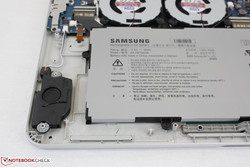
The internal 2 W stereo speakers are lacking not only in bass but also in volume. As shown by our pink noise measurements below, lower frequencies are not well represented and maximum volume is lower than expected. Users will likely be setting the volume to 70 percent or higher if watching videos as anything lower can be somewhat soft in a typical office or home environment. Fortunately, the speakers introduce no static, reverberations, or heavy imbalances no matter the volume setting.
Samsung Notebook 9 NP900X5N-X01US audio analysis
(-) | not very loud speakers (58.2 dB)
Bass 100 - 315 Hz
(-) | nearly no bass - on average 16% lower than median
(±) | linearity of bass is average (13.2% delta to prev. frequency)
Mids 400 - 2000 Hz
(+) | balanced mids - only 3.8% away from median
(+) | mids are linear (6.8% delta to prev. frequency)
Highs 2 - 16 kHz
(+) | balanced highs - only 4.4% away from median
(±) | linearity of highs is average (13.7% delta to prev. frequency)
Overall 100 - 16.000 Hz
(±) | linearity of overall sound is average (29.8% difference to median)
Compared to same class
» 95% of all tested devices in this class were better, 2% similar, 3% worse
» The best had a delta of 5%, average was 17%, worst was 45%
Compared to all devices tested
» 88% of all tested devices were better, 3% similar, 10% worse
» The best had a delta of 4%, average was 24%, worst was 134%
Apple MacBook 12 (Early 2016) 1.1 GHz audio analysis
(+) | speakers can play relatively loud (83.6 dB)
Bass 100 - 315 Hz
(±) | reduced bass - on average 11.3% lower than median
(±) | linearity of bass is average (14.2% delta to prev. frequency)
Mids 400 - 2000 Hz
(+) | balanced mids - only 2.4% away from median
(+) | mids are linear (5.5% delta to prev. frequency)
Highs 2 - 16 kHz
(+) | balanced highs - only 2% away from median
(+) | highs are linear (4.5% delta to prev. frequency)
Overall 100 - 16.000 Hz
(+) | overall sound is linear (10.2% difference to median)
Compared to same class
» 7% of all tested devices in this class were better, 2% similar, 91% worse
» The best had a delta of 5%, average was 18%, worst was 53%
Compared to all devices tested
» 4% of all tested devices were better, 1% similar, 94% worse
» The best had a delta of 4%, average was 24%, worst was 134%
Frequency Comparison (Checkbox selectable!)
Graph 1: Pink Noise 100% Vol.; Graph 2: Audio off
Energy Management
Power Consumption
The Samsung will consume anywhere from 5 W to 12 W depending on the Power Profile and display brightness when idling on desktop. Running 3DMark06 will draw about 48 W to be nearly identical to the similarly equipped Spectre x360 15.
Perhaps the more interesting observation is the system's unusually low maximum power draw of 55.7 W compared to 74.9 W on the Spectre x360 15. As shown by our GPU benchmarks above, the same GeForce 940MX GPU in the HP system handily outperforms the Samsung in all benchmark tests. The more reserved power consumption of the Samsung when under heavy loads may be responsible for its more middling GPU scores. The small power adapter (6.8 x 6.8 x 3.0 cm) is rated for an output of up to 65 W maximum, which is still lower than what the HP can provide.
| Off / Standby | |
| Idle | |
| Load |
|
Key:
min: | |
| Samsung Notebook 9 NP900X5N-X01US i7-7500U, GeForce 940MX, Samsung PM961 MZVLW256HEHP, IPS, 1920x1080, 15" | Dell XPS 15 9560 (i7-7700HQ, UHD) i7-7700HQ, GeForce GTX 1050 Mobile, Lite-On CX2-8B512-Q11, IGZO IPS, 3840x2160, 15.6" | Apple MacBook Pro 15 2016 (2.9 GHz, 460) 6920HQ, Radeon Pro 460, Apple SSD SM1024L, IPS, 2880x1800, 15.4" | HP Spectre x360 15-bl002xx i7-7500U, GeForce 940MX, Toshiba XG4 NVMe (THNSN5512GPUK), IPS, 3840x2160, 15.6" | Asus VivoBook S15 S510UA i5-7200U, HD Graphics 620, Toshiba HG6 THNSNJ128G8NY, IPS, 1920x1080, 15.6" | |
|---|---|---|---|---|---|
| Power Consumption | -91% | -12% | -18% | 28% | |
| Idle Minimum * (Watt) | 5 | 11.9 -138% | 3 40% | 8.14 -63% | 4.6 8% |
| Idle Average * (Watt) | 11.6 | 17.1 -47% | 9.9 15% | 10.91 6% | 7.6 34% |
| Idle Maximum * (Watt) | 12.2 | 17.3 -42% | 12.5 -2% | 12.26 -0% | 7.7 37% |
| Load Average * (Watt) | 47.8 | 94.7 -98% | 70.6 -48% | 45.67 4% | 35.1 27% |
| Witcher 3 ultra * (Watt) | 51.9 | 104.8 -102% | |||
| Load Maximum * (Watt) | 55.7 | 122 -119% | 90.8 -63% | 74.94 -35% | 36.2 35% |
* ... smaller is better
Battery Life
Runtimes are excellent from the internal 66 Wh battery at just over 10 hours of real-world WLAN use. Simply idling on desktop on the lowest brightness setting will last for over a full day and so standby time is impressively long before needing to recharge. Battery life is longer than the similarly configured Spectre x360 15 despite the HP carrying a larger capacity battery. The XPS 15 9560 will not lastly nearly as long due to its more powerful internals.
Charging from near empty to full capacity will take just over two hours through the AC adapter port. Charging through the USB Type-C port is possible with a generic 10 W (5 V, 2 A, BC 1.2-approved) adapter similar to those included with some smartphones, but Samsung themselves do not appear to offer any official USB Type-C chargers designed specifically for this notebook. We recommend using the included AC adapter for charging instead of resorting to third-party solutions whenever possible for more reliable charging.
| Samsung Notebook 9 NP900X5N-X01US i7-7500U, GeForce 940MX, 66 Wh | Dell XPS 15 9560 (i7-7700HQ, UHD) i7-7700HQ, GeForce GTX 1050 Mobile, 97 Wh | Apple MacBook Pro 15 2016 (2.9 GHz, 460) 6920HQ, Radeon Pro 460, 76 Wh | HP Spectre x360 15-bl002xx i7-7500U, GeForce 940MX, 79.2 Wh | Asus VivoBook S15 S510UA i5-7200U, HD Graphics 620, 42 Wh | Apple MacBook 13" T7200, Graphics Media Accelerator (GMA) 950, Wh | |
|---|---|---|---|---|---|---|
| Battery runtime | -30% | -26% | -9% | -52% | -36% | |
| Reader / Idle (h) | 27.4 | 13.9 -49% | 14.4 -47% | 10.2 -63% | 6.5 -76% | |
| WiFi v1.3 (h) | 10.1 | 7.2 -29% | 10.3 2% | 8.9 -12% | 4.3 -57% | |
| Load (h) | 1.9 | 1.7 -11% | 0.9 -53% | 2.5 32% | 1.2 -37% | 2 5% |
Pros
Cons
Verdict
The Notebook 9 NP900X5N excels in so many categories but misses the mark in a key few areas. We commend the manufacturer for being able to offer such a bright 1080p display on an extremely lightweight system and still have discrete graphics options available. If brightness, portability, longevity, Thunderbolt connectivity, and GeForce graphics are of priority, then the Notebook 9 becomes an easy recommendation especially if users find touchscreen options frivolous or 14-inch alternatives to be too small for productivity.
The Samsung is far from perfect and is merely average in chassis rigidity with some odd display configuration choices. As lovely as the narrow-bezel display may be, it is far more flexible than what competitors currently have to offer. It's strange that the glossy panel is mandatory and yet it carries no Gorilla Glass protection or touchscreen options that typically accompany it. The presence of PWM on nearly all brightness levels is another factor that some users may have to consider before purchasing.
Additionally, we're disappointed to see only the DDR3 GeForce 940MX version instead of the superior GDDR5 version especially since this particular GPU is aging very quickly. Nvidia will soon launch the GeForce MX150 for thin-and-light notebooks that will essentially make the 940MX series obsolete.
Finally, the system is priced quite high at $1400 USD for our particular configuration level. The pros still outweigh to cons so long as owners can avoid any bumps and bruises to the fragile lid.
The new Notebook 9 is unique due to its 15.0-inch screen size that occupies a void between 14-inch and 15.6-inch notebooks. It's surprisingly portable and comfortable to use especially for constant travelers, but the chassis could have benefited from more reinforcement.
Samsung Notebook 9 NP900X5N-X01US
- 06/15/2017 v6 (old)
Allen Ngo


